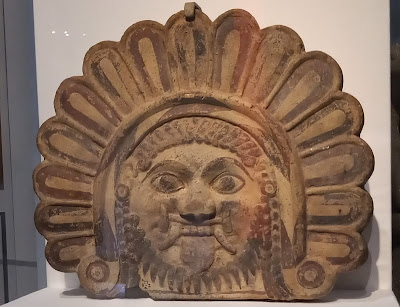In the past, before the 1960s, scholars tended to be men, and tended to interpret Goddesses as being related to fertility, even if it was a stretch to do so. For example, Robert Graves, in his book The Greek Myths which was published in 1955, wrote:
“The moon’s three phases of new, full, and old recalled the matriarch’s three phases of maiden, nymph (nubile woman), and crone. Then, since the sun’s annual course similarly recalled the rise and decline of her physical powers – spring a maiden, summer a nymph, winter a crone – the Goddess became identified with seasonal changes in animal and plant life; and thus with Mother Earth who, at the beginning of the vegetative year, produces only leaves and buds, then flowers and fruits, and at last ceases to bear.”
While many women have found it empowering to think of Goddesses in terms of maidens, mothers and crones, it doesn’t work for all. Personally, as someone who went through life without becoming a mother and am now old enough to be a crone but don’t particularly like to be called one, I prefer to look for other ways of perceiving feminine power.
The British Museum’s Feminine Power exhibition organises powerful female figures into five themes: creation and nature; passion and desire; magic and malice; justice and defence; and compassion, wisdom and salvation. The author of the exhibition catalogue, museum curator Belinda Crerar, explains: "Together, they show how feminine influence has been conceived in a phenomenal range of human experience.” Here’s an example in each of those categories from the exhibition and its catalogue.
Creation and Nature: This includes deities who gave birth to the world or to countries as well as those who are strongly associated with the land, sea, and all things growing including harvests. In the oldest Hindu texts, the Vedas, there are hymns to Prithvi (prith-vee), Goddess of the earth, creator of the world, and source of nourishment. The Vedic Goddess Shri is the embodiment of prosperity, royal power and beauty. Shri is known as Lakshmi in modern Hinduism and is associated with wealth, success and good fortune. To the right you can see a photo I took of her statue in the exhibition
Passion and Desire: Aphrodite was the Ancient Greek Goddess of grace, beauty and fecundity. She’s often thought of as a love Goddess, but is more than that. Her Roman equivalent is Venus. Both were considered important for martial success as well as in romantic situations. You can read more on my earlier blog post about her.
Magic and Malice: Medusa of Greek and Roman mythology, although often depicted as a monster, has also been portrayed as a victim, a metaphor for unrest, and a figurehead for feminist rage. At the top you can see a photo I took of her statue in the exhibition. Hekate stood at the crossroads between life and death for the Ancient Greeks and Romans, but is also protective and associated with witchcraft and magic. You can read more on my earlier blog post about her.
Justice and Defence: The Greek Goddess Athena embodied military strength; civic governance through justice; economic growth through industry; and art, philosophy and science. To the right you can see a photo I took of her statue in the exhibition.
Compassion and Salvation: In Buddhism, Bodhisattva are enlightened beings who guide others on their spiritual journeys. In some forms of Buddhism the Bodhisattva of Compassion is variously known as Avalokiteshvara (ava-low-key-tesh-vara), Guanyin, and Kannon, meaning Perceiver of sounds. She hears the cries of those who are suffering. I blogged about Guanyin earlier this week.
There are many other ways of thinking about the themes goddesses represent in general terms and I’ll be writing more on the topic of organising goddesses in the future. There's also a few more days to go and see the Feminine Power exhibition before it closes on September 25th. I thoroughly recommend it if you are in London and haven't seen it already.
I also in the past contributed to a book called Naming the Goddess, published by Moon Books. You can also find an extract from that here: http://www.badwitch.co.uk/2014/09/extract-naming-goddess-eris.html
You can view the exhibition catalogue for Feminine Power on Amazon
Other previous related posts
http://www.badwitch.co.uk/2022/05/launch-party-pics-feminine-power-at.html
http://www.badwitch.co.uk/2022/07/pagan-eye-sheela-na-gig-at-feminine.html
http://www.badwitch.co.uk/2022/06/book-review-feminine-power-exhibition.html
http://www.badwitch.co.uk/2022/07/altars-british-museum-goddess-day-focus.html





No comments:
Post a Comment